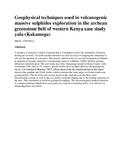| dc.contributor.author | MBAU, GITONGA | |
| dc.date.accessioned | 2013-02-15T07:23:47Z | |
| dc.date.issued | 2011 | |
| dc.identifier.citation | Bachelor of Science in Geology. | en |
| dc.identifier.uri | http://erepository.uonbi.ac.ke:8080/xmlui/handle/123456789/9959 | |
| dc.description.abstract | A prospect is restricted volume of ground that is considered to have the possibility of directly
hosting an ore body. As earth scientist therefore we look for ways of imaging the subsurface to
rule out the question of a prospect. This project addresses how to use electromagnetic technique
in imaging or locating conductive volcanogenic massive sulphides (VMS) and how geology
influences mineralization. The case study area Yala- Kakamega located in Busia County with
coordinates 0.06° and 34.32° where a ground follow up of an input airborne electromagnetic
survey was conducted (Barongo 1987). Observations from the interpreted data in this report
showed that graphite and Pyrite bodies which constitute the main target ore bodies reach near
ground surface. The ore body also occurs mostly in the andesites and rhyolites rocks
(Kavirondian system) as well as they are nearly vertically dipping due to the folding structures of
the area. This correlation is useful in geological mapping. The electromagnetic method therefore
is a simple technique which does not require any expensive trenching and is very effective in
delineating these ore bodies. | en |
| dc.language.iso | en | en |
| dc.publisher | University of Nairobi | en |
| dc.subject | Geophysical techniques | en |
| dc.subject | volcanogenic | en |
| dc.subject | sulphides exploration | en |
| dc.subject | greenstone belt | en |
| dc.subject | western Kenya, yala-(Kakamega) | en |
| dc.title | Geophysical techniques used in volcanogenic massive sulphides exploration in the archean greenstone belt of western Kenya case study yala-(Kakamega) | en |
| dc.type | Thesis | en |
| local.publisher | Geology | en |


